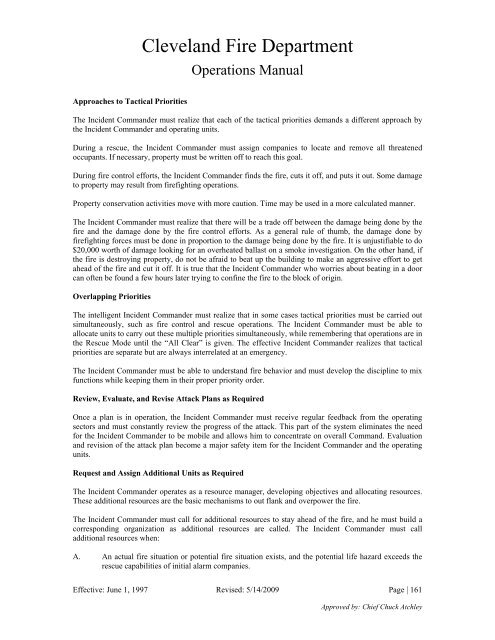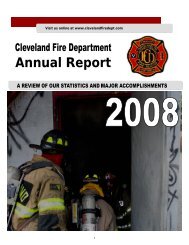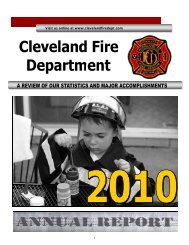SOP Manual - Cleveland Fire Department
SOP Manual - Cleveland Fire Department
SOP Manual - Cleveland Fire Department
- No tags were found...
You also want an ePaper? Increase the reach of your titles
YUMPU automatically turns print PDFs into web optimized ePapers that Google loves.
<strong>Cleveland</strong> <strong>Fire</strong> <strong>Department</strong><br />
Operations <strong>Manual</strong><br />
Approaches to Tactical Priorities<br />
The Incident Commander must realize that each of the tactical priorities demands a different approach by<br />
the Incident Commander and operating units.<br />
During a rescue, the Incident Commander must assign companies to locate and remove all threatened<br />
occupants. If necessary, property must be written off to reach this goal.<br />
During fire control efforts, the Incident Commander finds the fire, cuts it off, and puts it out. Some damage<br />
to property may result from firefighting operations.<br />
Property conservation activities move with more caution. Time may be used in a more calculated manner.<br />
The Incident Commander must realize that there will be a trade off between the damage being done by the<br />
fire and the damage done by the fire control efforts. As a general rule of thumb, the damage done by<br />
firefighting forces must be done in proportion to the damage being done by the fire. It is unjustifiable to do<br />
$20,000 worth of damage looking for an overheated ballast on a smoke investigation. On the other hand, if<br />
the fire is destroying property, do not be afraid to beat up the building to make an aggressive effort to get<br />
ahead of the fire and cut it off. It is true that the Incident Commander who worries about beating in a door<br />
can often be found a few hours later trying to confine the fire to the block of origin.<br />
Overlapping Priorities<br />
The intelligent Incident Commander must realize that in some cases tactical priorities must be carried out<br />
simultaneously, such as fire control and rescue operations. The Incident Commander must be able to<br />
allocate units to carry out these multiple priorities simultaneously, while remembering that operations are in<br />
the Rescue Mode until the “All Clear” is given. The effective Incident Commander realizes that tactical<br />
priorities are separate but are always interrelated at an emergency.<br />
The Incident Commander must be able to understand fire behavior and must develop the discipline to mix<br />
functions while keeping them in their proper priority order.<br />
Review, Evaluate, and Revise Attack Plans as Required<br />
Once a plan is in operation, the Incident Commander must receive regular feedback from the operating<br />
sectors and must constantly review the progress of the attack. This part of the system eliminates the need<br />
for the Incident Commander to be mobile and allows him to concentrate on overall Command. Evaluation<br />
and revision of the attack plan become a major safety item for the Incident Commander and the operating<br />
units.<br />
Request and Assign Additional Units as Required<br />
The Incident Commander operates as a resource manager, developing objectives and allocating resources.<br />
These additional resources are the basic mechanisms to out flank and overpower the fire.<br />
The Incident Commander must call for additional resources to stay ahead of the fire, and he must build a<br />
corresponding organization as additional resources are called. The Incident Commander must call<br />
additional resources when:<br />
A. An actual fire situation or potential fire situation exists, and the potential life hazard exceeds the<br />
rescue capabilities of initial alarm companies.<br />
Effective: June 1, 1997 Revised: 5/14/2009 Page | 161<br />
Approved by: Chief Chuck Atchley




